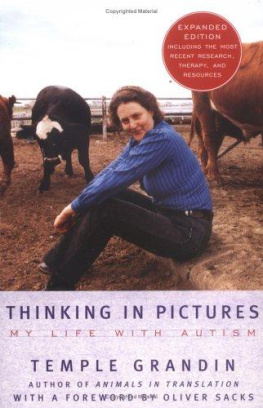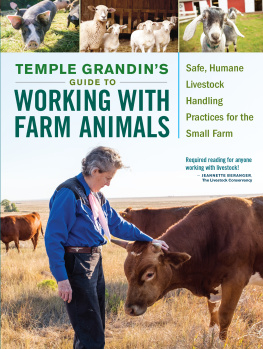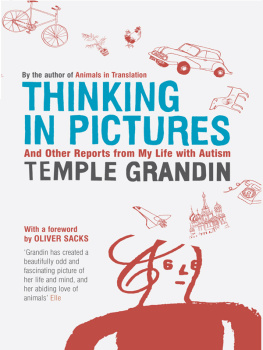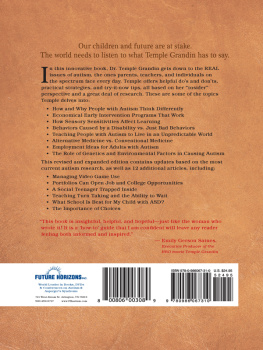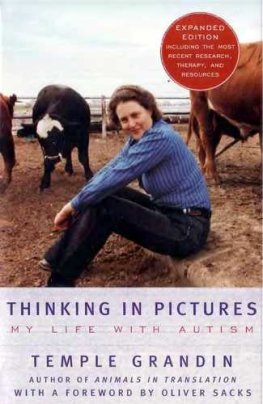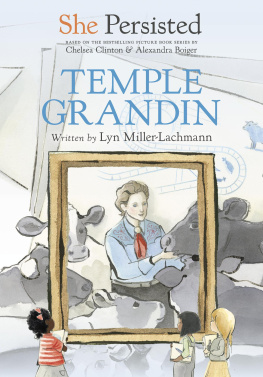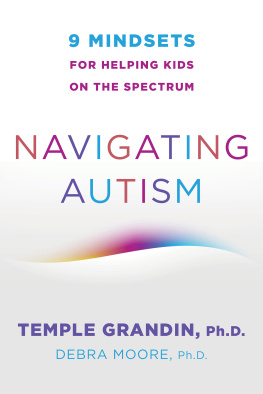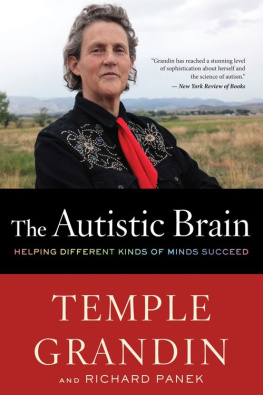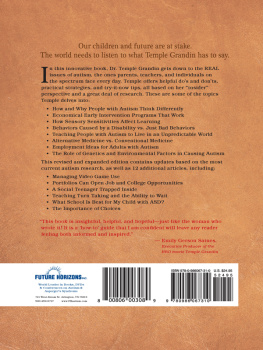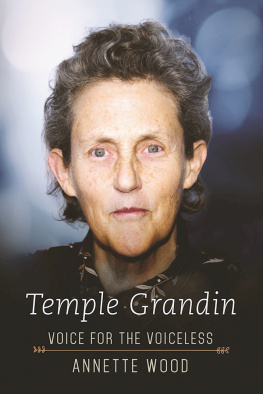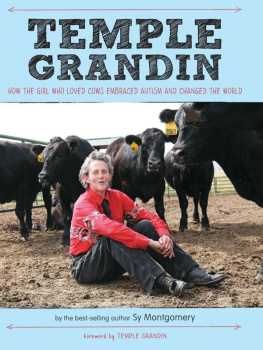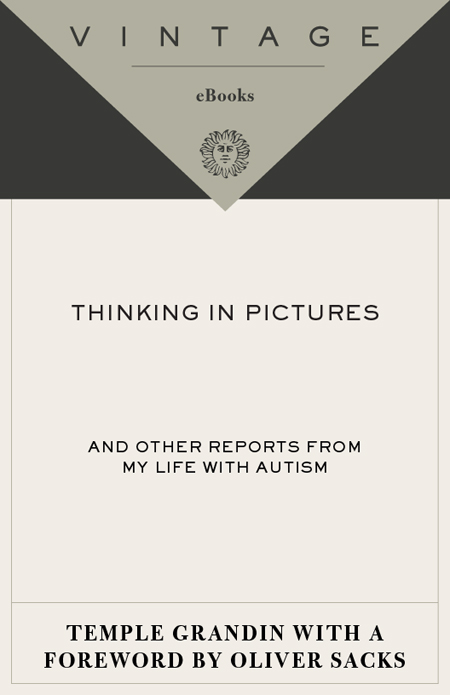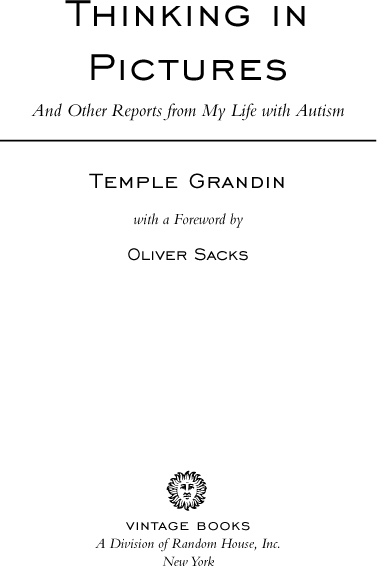Acclaim for Temple Grandin's
T HINKING IN P ICTURES
How does a true marvel let you know it has arrived? It's hard to imagine even an intellect as towering as Sacks's coming up with perceptions as rare and completely out of left field as Grandin herself does in this mind-blowing book.
Newsday
Temple Grandin's window onto the subjective experience of autism is of value to all of us who hope to gain a deeper understanding of the human mind by exploring the ways in which it responds to the world's challenges.
The Washington Times
Temple Grandin, the anthropologist from Mars, takes us on a journey through her inner life and, with exquisite scientific detail, offers us a near photograph of the workings of her visual mind.
John Ratey, coauthor of Driven to Distraction
Temple Grandin's legacy is the invaluable gift of compassion. This is a journey of courage, determination, and, above all, worth. Society is the better for Temple Grandin having left her mark on it.
Alex Pacheco, President, People for the Ethical Treatment of Animals
Thinking in Pictures is a beautiful book. Grandin has created a beautifully odd and fascinating picture of her life and mind, and her abiding love of animals.
Elle
A tireless researcher with a bionic memory and a superb education, no one can write with Temple's authority because nobody knows as much as she does! This is an outstanding book that every parent and professional in the field of special needs will want to read, and the general reader will acquire a new appreciation of autism, its liabilities, and its formidable assets.
Annabel Stehli, author of he Sound of a Miracle
Even Sacks's fine writing about autism does not really compare to writing from within autism, because autism is a disorder of interiority Grandin has replaced the teleology of autobiography with something much closer to her heart: a diagram, in this case a diagram of her own mind.
Voice Literary Supplement
TEMPLE GRANDIN
T HINKING IN P ICTURES
Temple Grandin has a Ph.D. in animal science from the University of Illinois and has designed one third of all the livestock-handling facilities in the United States, and many in other countries. She is currently an associate professor of animal sciences at Colorado State University and a frequent lecturer at autism meetings throughout the country. She lives in Fort Collins, Colorado.
BOOKS BY TEMPLE GRANDIN
Emergence: Labeled Autistic
Livestock Handling and Transport
Thinking in Pictures: And Other Reports from My Life with Autism
Genetics and the Behavior of Domestic Animals
Developing Talents
Animals in Translation
I dedicate this book to my mother.
Her love, dedication, and insight
enabled me to succeed.
A CKNOWLEDGMENTS
I would like to thank Diedra Enwright for typing the manuscript and Rosalie Winard for photography. I would also like to thank Betsy Lerner, my editor, for being patient and helping me organize my thoughts. Sequencing and organization are difficult for a visual thinker who has pictures for thoughts. I am also extremely grateful for the wonderful support from Dr. Oliver Sacks. Other people who have made this project possible were Pat Breinin, my agent, and Brandon Saltz, editorial assistant at Doubleday I would like to conclude by thanking Mark Deesing, Mary Tanner, and Julie Struthers for library research.
C ONTENTS
1
Thinking in Pictures
Autism and Visual Thought
2
T HE G REAT C ONTINUUM
Diagnosing Autism
3
T HE S QUEEZE M ACHINE
Sensory Problems in Autism
4
L EARNING E MPATHY
Emotion and Autism
5
T HE W AYS OF THE W ORLD
Developing Autistic Talent
6
B ELIEVER IN B IOCHEMISTRY
Medications and New Treatments
7
D ATING D ATA
Autism and Relationships
8
A C OW'S E YE V IEW
Connecting with Animals
9
A RTISTS AND A CCOUNTANTS
An Understanding of Animal Thought
10
E INSTEIN'S S ECOND C OUSIN
The Link Between Autism and Genius
11
S TAIRWAY TO H EAVEN
Religion and Belief
A NOTE FROM THE AUTHOR
In the ten years since the initial publication of Thinking in Pictures our understanding of autism has changed a great deal. The Asperger's Syndrome diagnosis was rarely used in the United States, and now has become much more frequent. Our understanding of medications was not as advanced. There were fewer scientific references available. We have also learned a great deal about different kinds of autistic thinkersnot all autistic individuals are visual thinkers. In an effort to keep Thinking in Pictures as up-to-date and useful as possible I have taken into consideration the new studies, diagnoses, and treatments for autism and written updates following each chapter. The original text has not been changed. The updated sections are clearly marked. I have also added ninety new references and many new resources and useful Web sites.
Temple Grandin
August 4, 2005
F OREWORD
Oliver Sacks
IN 1986 a quite extraordinary, unprecedented and, in a way, unthinkable book was published, Temple Grandin's Emergence: Labeled Autistic. Unprecedented because there had never before been an inside narrative of autism; unthinkable because it had been medical dogma for forty years or more that there was no inside, no inner life, in the autistic, or that if there was it would be forever denied access or expression; extraordinary because of its extreme (and strange) directness and clarity Temple Grandin's voice came from a place which had never had a voice, never been granted real existence, beforeand she spoke not only for herself, but for thousands of other, often highly gifted, autistic adults in our midst. She provided a glimpse, and indeed a revelation, that there might be people, no less human than ourselves, who constructed their worlds, lived their lives, in almost unimaginably different ways.
The word autism still conveys a fixed and dreadful meaning to most peoplethey visualize a child mute, rocking, screaming, inaccessible, cut off from human contact. And we almost always speak of autistic children, never of autistic adults, as if such children never grew up, or were somehow mysteriously spirited off the planet, out of society. Or else we think of an autistic savant, a strange being with bizarre mannerisms and stereotypies, still cut off from normal life, but with uncanny powers of calculation, memory, drawing, whateverlike the savant portrayed in Rain Man. These pictures are not wholly false, but they fail to indicate that there are forms of autism which (while they may indeed go with ways of thinking and perceiving very different from the normal) do not incapacitate in the same way, but may (especially if there is high intelligence, and understanding, and education) allow lives that are full of event and achievement, and a special sort of insight and courage too.
This was well realized by Hans Asperger, who described these higher forms of autism in 1944but Asperger's paper, published in German, was virtually ignored for forty years. Then, in 1986, came Temple's startling book,

